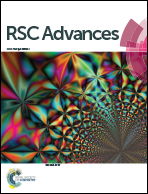Sub-nanograin metal based high efficiency multilayer reflective optics for high energies†
Abstract
The present finding illuminates the physics of the formation of interfaces of metal based hetero-structures near layer continuous limit as an approach to develop high-efficiency W/B4C multilayer (ML) optics with ML periodicity varying d = 1.86–1.23 nm at a fixed number of layer pairs N = 400. The microstructure of metal layers is tailored near the onset of grain growth to control the surface density of grains resulting in small average sizes of grains to sub-nanometers. This generates concurrently desirable atomically sharp interfaces, high optical contrast, and desirable stress properties over a large number of periods, which have evidence through the developed ML optics. We demonstrate significantly high reflectivities of ML optics measured in the energy range 10–20 keV, except for d = 1.23 nm due to quasi-continuous layers. The reflectivities at soft gamma-rays are predicted.



 Please wait while we load your content...
Please wait while we load your content...